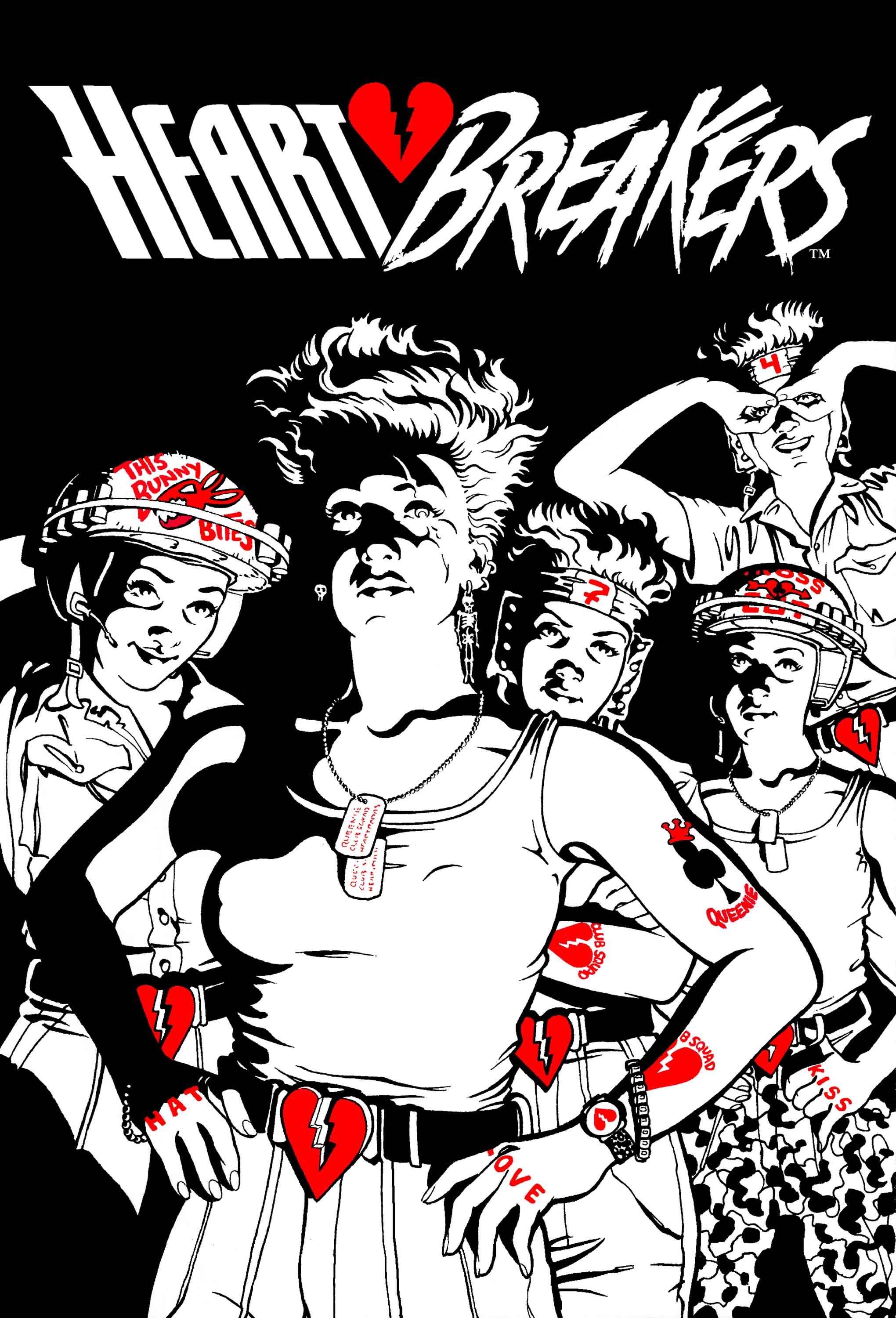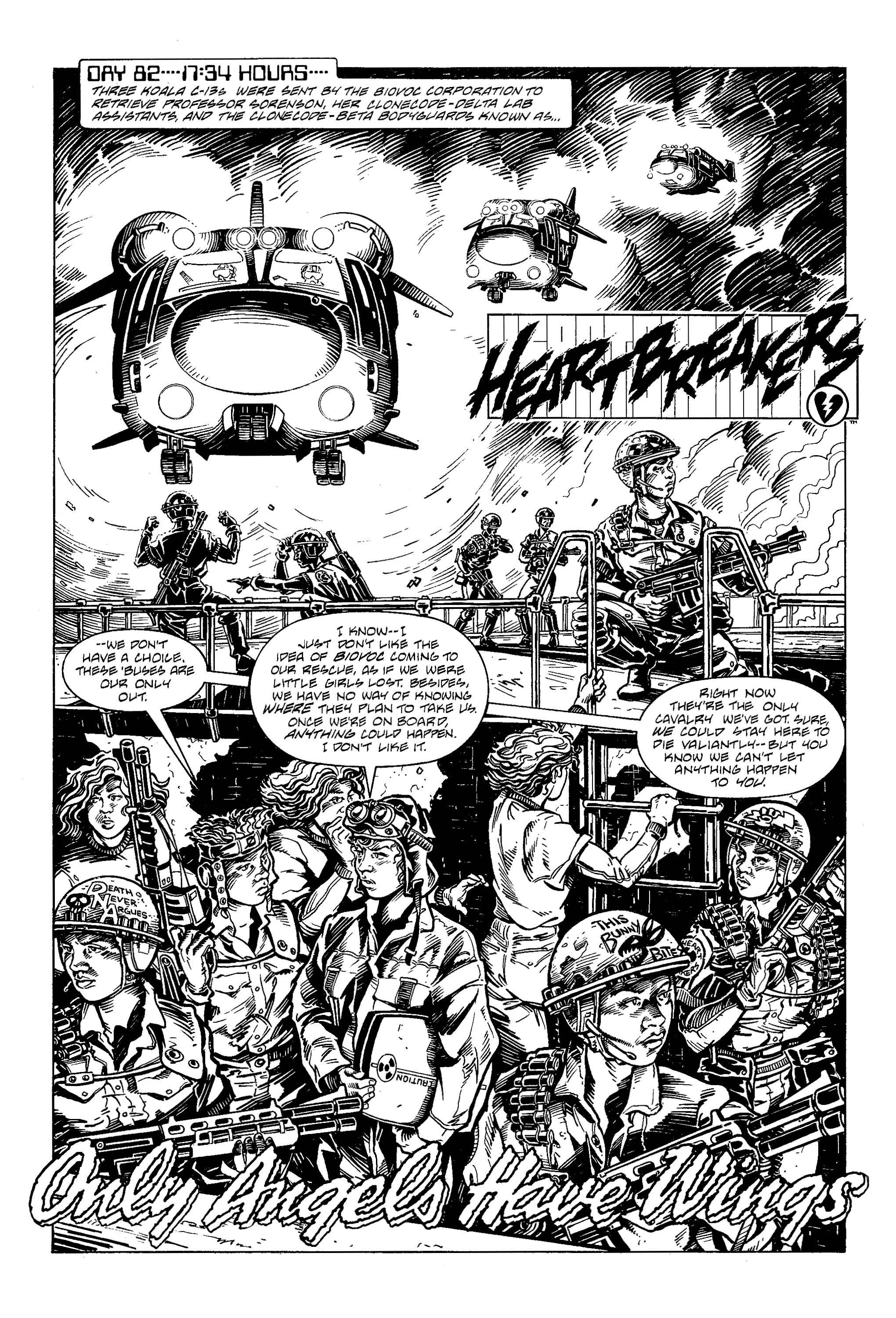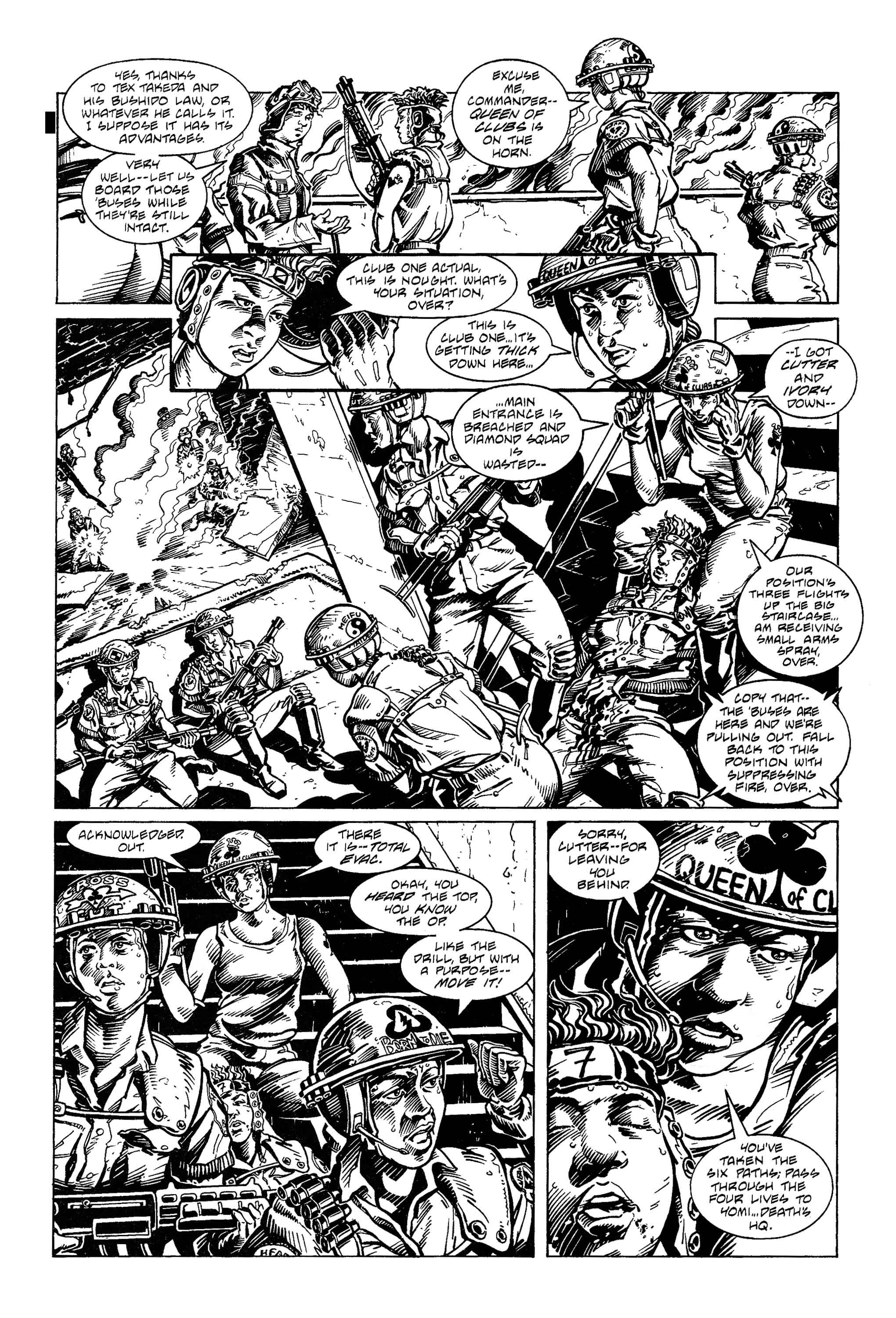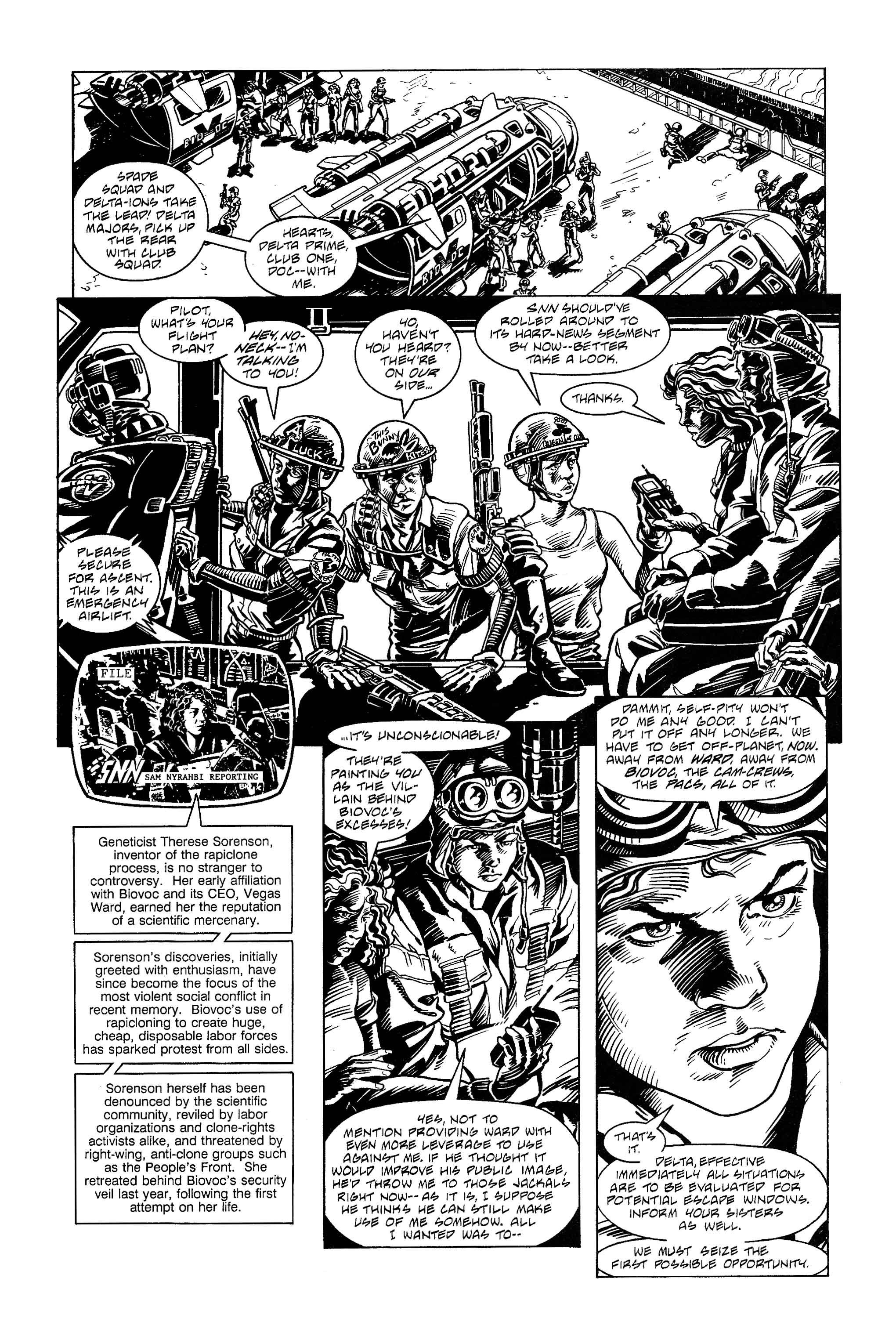Writer Anina Bennett and artist Paul Guinan join the Monkeybrain Comics line with today's digital re-release of first episode of their creator-owned Heartbreakers, which originally appeared in Dark Horse Presents #35 in 1989.
The sci-fi adventure has gathered has gathered a growing following over the years, and as it turns out Monkeybrain Co-Publisher Chris Roberson is one of those longtime fans.
Bennett and Guinan spoke with ROBOT 6 about the history and influence of Heartbreakers, its digital debut, and why they partnered with Monkeybrain. To learn how real-world events helped to change the direction of Heartbreakers makes me even more interested to see how Bennett and Guinan plan to observe the comic's 25th anniversary next year.
If you're attending Comic-Con International in San Diego, be sure to visit Bennett and Guinan in Artists Alley at Booth CC-01.
Tim O'Shea: When did the rights to Heartbreakers revert back to you, and how long had you been considering taking the work to the digital platform before making the leap? Did you seek out Monkeybrain, or did they seek you?
Paul Guinan: We always had the rights to Heartbreakers, since it started out at Dark Horse with full creator ownership in 1989. In recent years, a lot of fans started asking when we were going to do more Heartbreakers stories, and we noticed we were picking up new fans who found the series in back-issue bins. One of them even had Queenie tattoos! We also wanted to do something special in print for the 25th anniversary of the series in 2014. Finally a light bulb went off, and we thought “Hey, we should reissue these digitally. Heartbreakers has staying power.”
Anina Bennett: Initially, we planned to go to comiXology on our own. Then we met Allison Baker and Chris Roberson, the brains behind Monkeybrain, after they moved to Portland in 2012. Their publishing model is smart, their books are all good, and it turns out Chris is a Heartbreakers fan. Plus they’re great people. It’s a match made in comic-book heaven.
Kurt Busiek doesn't praise all work as enthusiastically as when he described Heartbreakers as "fiercely intelligent action/adventure". How challenging is it to create intelligent stories infused with action without having either aspect be short-changed?
Anina: For us, it’s hard to do stories that aren’t intelligent in some way. That may sound egotistical, but it’s the simplest way to say it. Heartbreakers is all action on the surface, but at heart, it’s about the nature of human identity. We also address issues of corporate ownership, race, gender, politics, etc. For example, clones are considered property and prohibited from reproducing themselves. So “reproductive rights” are a huge issue for them, but in Heartbreakers, that phrase means “the right to reproduce by choice.”
I think we’ve gotten better at balancing the different elements over the years. The early HB stories are very talky, partly because we condensed them from longer arcs. If I wrote them today, there would be a lot less dialogue.
We did decide to change certain elements in the series as it progressed, to downplay some aspects we became uncomfortable with. The Dark Horse story arcs involve a lot of gunplay, partly because we were into John Woo movies at the time, and Queenie wears a bra top. Well, back in the 1990s there was what you might call a character fad that got nicknamed “Bad Girls,” and our characters got lumped in with some other books that we felt were exploitive.
We didn’t want to overly sexualize our characters through their clothing, nor did we want to portray casual gun violence. So we switched from guns to kung fu — there’s even a panel in Heartbreakers Meet Boilerplate where we reference that — and ditched the bra tops. The later stories are still sci-fi action-adventure, but they have a somewhat lighter tone.
We made that switch around 1998. The following year, there was a mass shooting at Columbine High School that people still talk about. I’m happy with our decision to retire the shoot-’em-up style.
Over the years since your created Heartbreakers, have you heard from other creators inspired by your work to develop stories with strong female characters?
Anina: Yes, we have. One of my favorite examples is Carla Speed McNeil, who does the wonderful series Finder. I almost fell over when she told me that Heartbreakers inspired her. That’s one of the most rewarding things a creator can hear.
What prompted you to explore the impact of cloning and genetic engineering in the first place?
Anina: I’m a science nerd, among other passions, and we’re both lifelong science fiction fans. These subjects were heavily explored in classic sci fi, plus in the 1980s I was reading about early genetic research and all kinds of other cutting-edge stuff in Science News magazine.
When Paul hatched the idea of a platoon of genetically engineered soldier clones, I immediately loved it and countered with the suggestion that we add a group of clones designed to be lab assistants. They’re all based on the same DNA — that of their creator, Therese Sorenson — but they’re built for different purposes, and each one has unique experiences after being “born” as an individual.
So they’re the same yet not the same, even within each group of clones. And the soldier/scientist setup gives us a fun character combo of brains and brawn to play with. Without spoiling any plot twists, I will add that one of the scientist clones eventually has an identity crisis because the soldier clones equate her with Sorenson.
In taking it digital, was there ever any consideration of coloring the story, or was this project best suited for black and white?
Paul: The Dark Horse Presents stories are black-and-white, while some of the later Heartbreakers stories are full color. The black-and-white art was designed to not be colored, so we’re leaving it that way. At this point, I don’t think there’s a bias against black-and-white comics among most readers, so we wouldn’t gain anything except delays by coloring it.
For years you have sold Heartbreakers action figures on your website, if you end up selling out of the ones you have left (due to the influx of new readers you gain). Any interest in producing more, or are you two out of the action figure biz after that?
Paul: We started making custom Heartbreakers action figures and dolls as part of our convention table display in the 1990s, including a giant one converted from a “My Size Barbie.” They’re featured in a fumetti-style story called "Small World" in Heartbreakers Superdigest. We’re no longer selling the last few original figures, but people can commission new figures via our website.
Anina, you describe yourself as a recovering comic book editor in your bio, having edited Nexus, GrimJack and Harlan Ellison's Dream Corridor. Did you find editing those creators helped you in any way to become a better writer?
Anina: Absolutely. Despite the fact that First Comics was foundering when I started working there in 1989, I was incredibly lucky to work with creators like John Ostrander, Mike Baron, Steve Rude and Steven Grant, right out of the gate. Then I moved to Dark Horse along with Nexus, where I edited books by Harlan Ellison (to the extent possible), Jim Krueger and Mike Oeming, Gerry Jones and Gene Ha, Al Williamson, Eric Shanower… the list goes on. I learned something from every one of them. My dialogue is now much more efficient, and I have a stronger understanding of story structure, pacing, and character arcs. I try to also learn from every story I read and watch.
Paul, did growing up as the son of artist Robert Guinan have any impact at all on your interest in pursuing an art career?
Paul: Oh, yeah. I was doomed from birth — both of my parents are visual artists, and I’m named after Paul Gauguin and Vincent van Gogh. I started drawing my own comics when I was five years old, I think. The only difference is that my dad is considered a “fine artist,” whereas I’m a “commercial artist.”
Both of you are on Twitter, what value is social media to you as a tool for promoting your work (as Paul did here)?
Anina: Boy, I wish we’d had access to social media back in the 1990s! It was so much harder then to get the word out to your potential audience, including the comic shops that place the initial orders and essentially determine the print run in the direct sales market. Twitter, Facebook, Tumblr, and other social media platforms are potentially a good means of spreading the word and generating interest, but you have to understand that each one of them has its own culture. I’m still working on that.
The drawbacks are that it can become very time-consuming to build your “brand” and maintain your presence online in a way that truly engages people, plus the signal-to-noise ratio is much higher than it was 20 years ago. There’s simply too much product out there, in every medium, and it’s impossible for people to even be aware of it all, much less read/consume it all.
At what point in working on the Heartbreakers series initially did you realize it was becoming regarded as groundbreaking, and how did it feel once you realized your hard work had connected with people to such a successful degree?
Paul: When I noticed that a flood of similar characters was popping up in comics and other media, such as Martha Washington, Barb Wire and Lara Croft. Clearly, we had hit — maybe even helped spark — a zeitgeist moment.
As for our work connecting with people, I’m not sure we realized until recently how much Heartbreakers resonates with our readership. As Anina said earlier, more and more people have been asking us about it in the past five years or so. Just this summer, one of our friends in Portland told us that our DHP stories “changed his life” when he was 12, because they opened his eyes to the fact that comics weren’t just about superheroes — that you could do anything in comics. Can you imagine? Even if that were the only reader feedback we’d ever gotten, it would be enough.
How does one find themselves playing Spock's parents in a Trek in the Park production?
Anina: Ha! Step 1: Get to know the director and producer, sibling team Adam and Amy Rosko. We had seen Atomic Arts’ previous Trek in the Park productions and loved them. The staging is so creative, and they’re performed with affection and gusto. When Adam decided to stage the classic Star Trek episode “Journey to Babel,” we had to audition. How often do you get a chance to be Spock’s parents? That’s a once-in-a-lifetime opportunity. And it was a blast. We expect great things from Atomic Arts in their future productions.
Paul: For the uninitiated, Trek in the Park is a bona fide Portland phenom — it’s like Shakespeare in the park, except each year they stage a live performance of a classic Trek episode. It’s been featured on Portlandia and CBS Sunday Morning. This summer is the final mission; we’re doing “The Trouble with Tribbles,” the first four weekends in August. It’s worth a trip to Portland if you can make it.
What am I neglecting to ask you about?
Paul: People can find out more about us and our work, including our recent books Boilerplate and Frank Reade, on our website. And of course on Twitter (@Boilerplate1893 and @bigredhair) and other social media. There’s a Facebook group for each of our books, including Heartbreakers, so join up!





